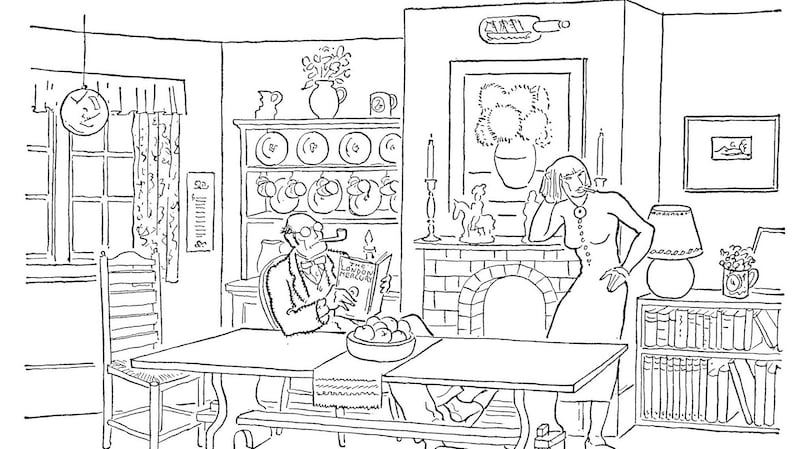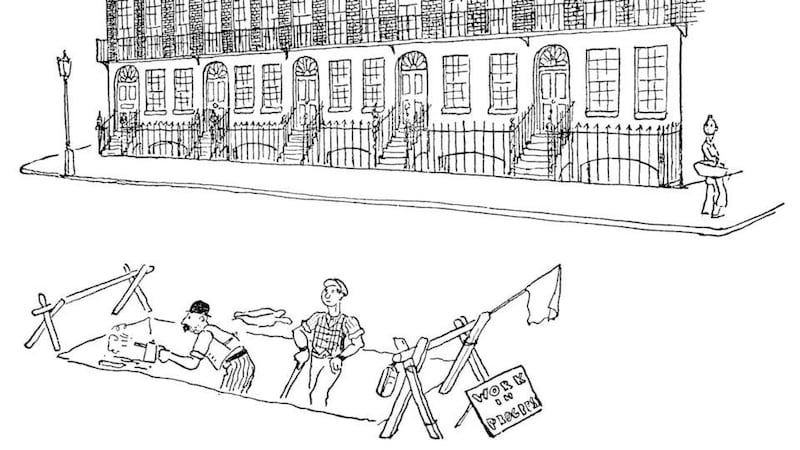Osbert Lancaster did not have to look far for caricature. Sporting a walrus moustache and always dressed in true dapper dandy style with tweeds or pinstripes, he possessed all the natural self-awareness he and other members of the Brideshead Revisited brigade brought to any luncheon.
A rambunctious figure, Lancaster could easily have bounded out of a PG Wodehouse novel; in many photographs he looks like Laurence Olivier with a few extra potatoes.
However, beneath this surface of seeming superciliousness lay depths of talent and discernment. Lancaster was a designer, cartoonist, writer on architecture and travel and humorist. He enjoyed nothing more than poking fun at the very establishment to which he belonged. His work is in print again thanks to Pimpernel Press, which has published a beautiful three-volume slipcase edition of Osbert Lancaster's Cartoons, Columns and Curlicues.


The books are made up of Lancaster's architectural drawings published across the period of the second World War, tracing the line between the pre-war ideas of preservation and the post-1945 movement towards renewal and reinvention. In the introduction to the first of these books, Pillar to Post, Lancaster threw his jocular saddle over a po-faced subject: "All the architecture in this book is completely imaginary, and no reference is intended to any actual building living or dead."
The drawings that follow are satirical, funny and extremely accurate; so much so that his descriptions were added to the design lexicon. The phrases "Banker's Georgian", "Pont Street Dutch", "Pseudish" and "Stockbroker's Tudor" are all used today. Looking at his drawing Twentieth Century Functional (right), it is fair to say he flagged part of the embryonic modernist movement: a cubist house with a touch of the Mad Men lifestyle thrown in as a hip couple sunbathe on a rooftop, no doubt waiting for cocktail o'clock.
The other volumes, Home Sweet Homes and Drayneflete Revealed, cast an irreverent eye towards matters of domesticity and presaged some of the conflicts found within the good intentions of the New Town planners (The Drayneflete of Tomorrow perfectly encapsulates the new city ideology of grids, boulevards, airports and high rises). Lancaster coined more new terms for suburban living in these volumes – such as "By-Pass Variegated" and "Aldwych Farcical" – and always made sure to include the one thing that seemed almost sacrilegious to architectural design and drawing: people.
Lancaster's visions contained such a sharp, satirical edge that long-time friend John Betjeman noted: "My only fear . . . is that some town councils may get hold of [these books] and take it literally."
His drawings also poked fun at some sacred political cows. At a time when some on the left were apologising for or turning a blind eye to Stalin's Soviet Union, while condemning the actions of Hitler and the Third Reich, Lancaster made two drawings side-by-side in Pillar to Post. Titled Third Empire and Marxist Non-Aryan, it showed identical structures and designs, bar the easily adjusted window-dressing of Stalinist and Nazism military insignia.
Freelance illustrator
Lancaster was born in Notting Hill, London in 1908, and after leaving Oxford with a fourth-class degree and failing his exams to enter the legal world, he found himself somewhat adrift.
Art school did not work out for him either, so he started out as a freelance illustrator, designing posters for London Transport and other companies.
Betjeman was working on the Architectural Review by the 1930s and soon got his old pal involved. This led to a job with the Daily Express, when it was still a newspaper of note. It was there that Lancaster pioneered the pocket cartoon with which we are all familiar now: a single panel, single column drawing. He became part of the Fleet Street furniture during this golden age of newspaper journalism, contributing an estimated 10,000 cartoons over a period of 40 years.
"He was a bastard," Lancaster later said of Express proprietor Lord Beaverbrook, "but by God he knew his journalism."
The books on architecture are what Lancaster should be best remembered for though. They are humorous first and foremost, but they also helped disseminate knowledge of architectural styles to many people. The drawings and designs allowed people to have the confidence to critique new fads, while at the same time they gave welcome voice to the conservation calls in the urban planning debate.
It could be argued that Drayneflete Revealed was a much greater force on the issue of urban renewal compared with a 5,000-word polemic, for the simple reason that more people would read it, and, just as importantly, turn the pages joyfully to watch the argument played out.
"The object of this book," Lancaster wrote of Pillar to Post, "is to induce an attitude to architecture less reverent and of greater awareness." The books are of their time, of course, but their legacy is part of the strong heritage culture that we rightly fight for today.
When Osbert Lancaster died in 1986, the Times said that "with his poached-egg eyes, martial moustaches, tweedily dandified clothes and bufferish pose as the last of the great clubmen, he seemed to have stepped out of the magically preposterous world of his own drawings".
Not a bad epitaph for a boy with a fourth-class degree.
Osbert Lancaster's Cartoons, Columns and Curlicues is published by Pimpernel Press (£40)











